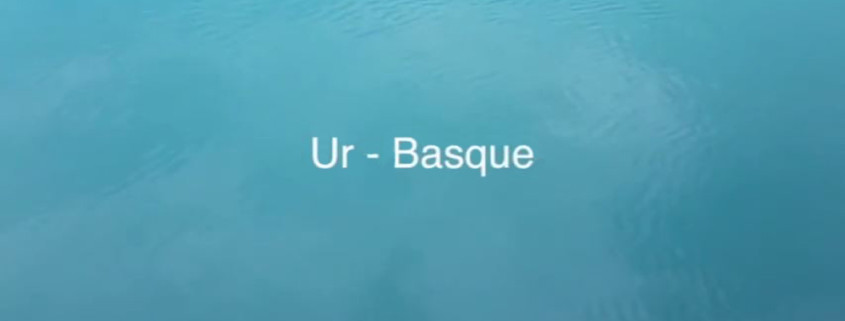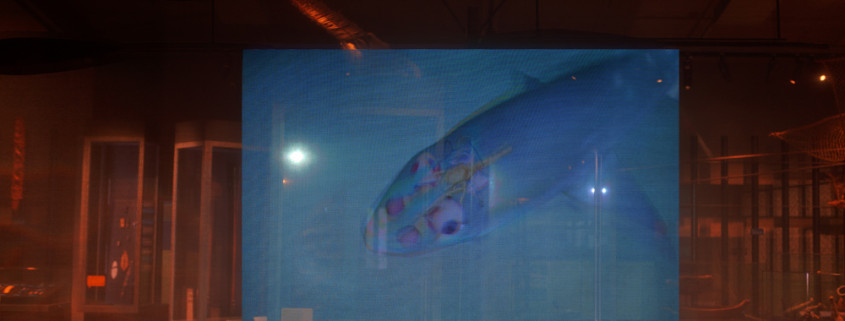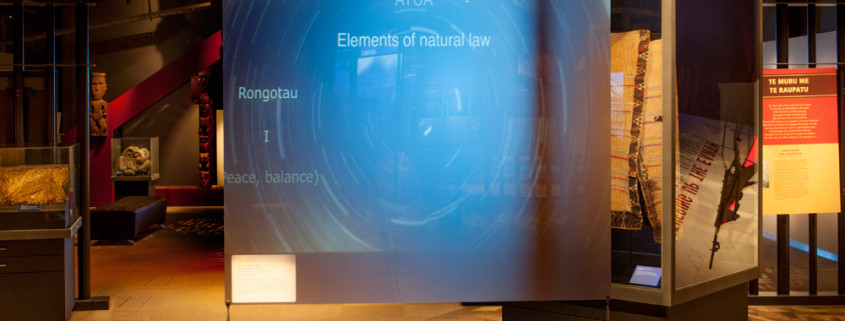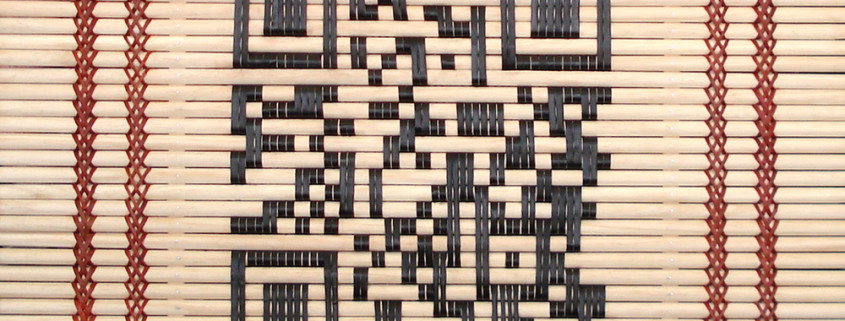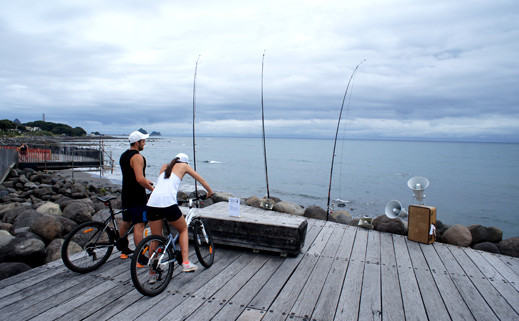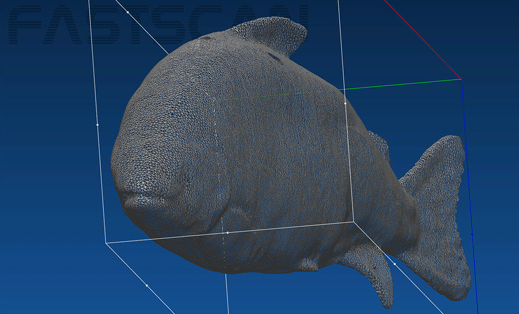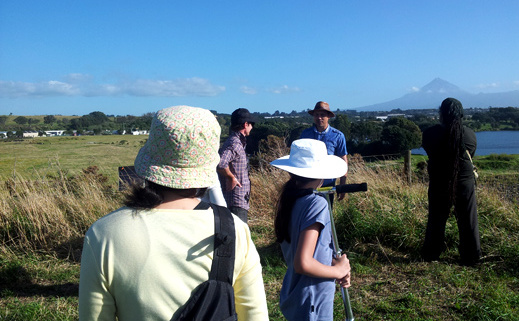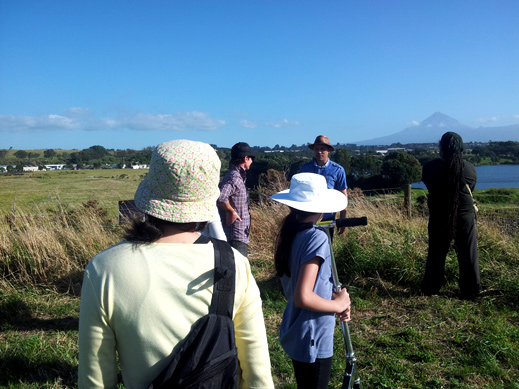Posts
The electromagnetic sensory world of sharks by Mike Paulin
/in 3rd Nature Exhibition /by Ian ClothierPattern Recognition by Vicki Smith and Aroha Timoti
/in Context, Media Art Projects /by Ian ClothierAllan Giddy at SCANZ
/in Uncategorised /by Ian ClothierAlternative energy pioneer Allan Giddy exhibited two works at SCANZ2015. The first was the night time projection of Night swimmer onto a small stream in Pukekura Park. The second, England Expects … (Aotearoa) 2014-15 was installed on the foreshore by the Huatoki outlet. The installation is solar powered, and uses three mics on the tips of fishing lines – which turns them into aeolian harps (which are blown by the wind). The audio created is mixed with the UK weather forecast, and a recorded response by violinist Alison Blunt of the London Improvisers Orchestra. A special implementation of England Expects … (Aotearoa) 2014-15 at SCANZ involved waiata sung by Jo Tito, connecting the specific location to the British influences in the work.
Digitized 3D Objects and Audio Signal Convergence by Claire Brunet, Susan Fryberg and Toby Gifford
/in 2015 Projects /by Ian ClothierRecordings of water, specifically chosen to make audible water’s numinous quality, are modified through signal processing mechanisms that are derived from digitised 3D objects. These will be played back along a public waterway, through solar powered speakers, as part of the SCANZ temporary public art works section. Projections of 3D forms data using a portable power generator are linked to the concept of water and its sustainability, and supported by sound. A stretched white net will be used as a projection screen.
Through exploring the ways in which the data from the digitized objects and forms are transformed and translated from nature to code to signal processing mechanisms, we investigate the plural condition of the digital medium. The work explores both interactions with digital data impact on ar1ists’ perception and interaction with the natural environment and foster a plurality of creative approaches. From a research/creation experiential mode of inquiry we investigate the ways in which the digitalisation of spatial, temporal and sonic modalities, impacts on interdisciplinary artistic concepts.
The Project team comprises the following artists: Claire Brunet, sculptor working with 3D digital technology who is completing a PhD on the impact of 3d digital technology and technological environment on sculpture installation art; Susan Frykberg, a composer of electro/acoustic music who often combines feminist, spiritual and social ideas in her work, and Toby Gifford, a music technologist sound designer and acoustic musician who has completed his PhD in interactive music systems, will offer technical support. The project we propose for Water and/or Peace residency and temporary public work (residency with public exhibition project) presents a multidisciplinary approach to the ways in which artists and the audience adapt to a creative experience.
The project combines music and sculptural forms data inside a digital context where sound, space, time and materiality are explored through a digital medium. It addresses an ecological and trans-national discourse, referencing water as an essential element of life. Original recordings, images and 3D objects are sourced from the physical space and location of the three artists – Canada, New Zealand and Australia. Sonic material from recordings of waters will be modified through granular synthesis and digital signal processing, through data obtained from a digital representation of manipulated data forms.
A number of software platforms will be used for this including Max and Ableton Live. Water sounds, changed by the data obtained through scanned elements from nature, parallel the interrelationship of the fish and water. Solar powered speakers will be used to make audible the sonic material.
Image projection will include a digital representation of manipulated data of a salmon form. The fish is an iconic figure of Canadian marine life and is also present in New Zealand and Australia. It is a visual metaphor for the complexity of the living condition. As a way to express the paradoxical aspect of life, the fish species selected also symbolizes the strength of nature’s instinct for survival. On site access to a portable power generator will supply energy for the data projector, allowing projections of 3D forms in nature. A stretched white net will be used as a projection screen.
This sound/projection multimedia installation project will enable us to explore new ways of looking, inventing, imagining and expressing past, present and future perceptions and interactions witl1 tl1e world in which we live. The main focus of our work is nature, transformation and change, through which we address ecological issues via the theme of water.
Ko Tatou te Tangata: talk
/in Media Art Projects /by Ian ClothierAs part of Intercreate’s Media Art Project Ko Tatou te Tangata a series of meetings and discussions with local iwi Ngati Tawhirikura were held, co-ordinated by Kura Puke and Stu Foster. One of the consequences of these discussion was that local historian and Puke Ariki Poutiaki Taonga Glen Skipper gave a talk about Te Rewa Rewa pa, at the pa site. One aim of the Media Art Project is to direct a laser from Katere Ki Te Moana marae to Te Rewa Rewa pa. The laser will carry audio contributed by local tangata whenua (people of the land, as Maori refer to themselves). The pa, now uninhabited, is a large site on the New Plymouth foreshore.
The two sites are connected by whakapapa (genealogy) people and history. Where once there was large settlement at Te Rewa Rewa, now the closest marae is Katere, which is several kilometres away. To direct laser light across the whenua (land), through the night sky carrying traditional knowledge and awareness is to re-awaken connection to place, and the project has facilitated this process greatly.
When standing on Te Rewa Rewa, the look and feel is that of farmed land, with a large open flat space at a good height for local visibility and indeed the land is leased to a farmer presently. Pieces of history are everywhere, with small entrances to mid 20th century structures, and pits in the flat plateau. The story of this land, its people, events, the politics, intrigue, comings and goings rise from hidden earth as Skipper takes us further into this place and it’s surrounds. Here, buried from everyday consciousness and awakened by the project are the many energies that constitute the living past, the veil having been lifted in the most delicate way by the efforts of Puke and Foster.
huatoki-walkway3
/in 2015 Locations /by Ian ClothierHuatoki walkway: history unveiled
It is interesting that following a river cuts across the urban city landscape and the corresponding histories of place. Nature and heritage are often obscured when the experience of place is dominated by being in buildings, and walking, taking a bus or driving the streets. To follow a river is to connect them all.

This looks like a collection of boulders, but once was a large marker rock used by local iwi (tribes). It was dynamited in the colonial era

The view looking upward toward the end of the town centre part of the walkway. If needed further sites are located beyond
scanz2015:water*peace-call
/in Featured /by Ian ClothierCall for projects
Water*peace
Water is essential to survival, revered and respected worldwide for its power, curative and creative abilities. Water as a resource has become intensely politicised and monetised, in contrast to the view that access to fresh water is a fundamental human right. Peace is also essential to the sustainability of humans on Earth. Join us to discuss and put forward positive, connecting views on water and peace that engages our community. This is the first call for projects and residency with submissions due November 8, 2013 (this allows for planning and fundraising). Read more…
Noho marae
SCANZ2015: water*peace will be the fifth SCANZ residency and starts in January 2015. It will commence with noho marae (overnight stay) at Parihaka, world renowned as a site of peaceful protest. The stay coincides with the 18th and 19th, when Te Whiti and Tohu, leaders of the peace movement are celebrated.
Open residency
This will be followed by a two week open, creative and interdisciplinary residency. It is our hope that tangata whenua, indigenous peoples, New Zealanders and other global citizens will be able to take part.
We are suggesting that artists, environmentalists, technologists, scientists, writers, performers, dancers and people interested in the positive aspects of water and peace, all take part. Anyone can submit a project in one or more of the categories listed further down this page.
Temporary works in public space
We would like to have five to seven temporary works in public space, shown for one day or overnight on the final weekend of the residency. These will be sited along a river walkway. No power will be provided at the sites, so solar, wind, and water powered projects are suitable (battery and static install are two further options).
Day of public activities about water, water quality and peace
We are seeking proposals for a day of activities that engage our local community in issues around water and peace.
Night time building projections
We are seeking projection works about water or peace, to be projected on to the side of a local building in the evening.
Online exhibition
Links to water and peace resources online will be collated. Included will be a curated selection of online projects about water and/or peace.
SCANZ hui
On the final weekend of the residency there will be a SCANZ hui. Day one is at WITT, the local polytechnic and allows for presentations that require technology, the internet, projectors etc. Day two is a walking symposium to view the artworks and have thematic discussions in the environment of the river walkways.
A separate call for hui/symposium presentations will be made at a later date, through the same application page on Easy Chair.
Categories of projects
Water and/or Peace residency and temporary public work (residency with public exhibition project)
Water and/or Peace residency (residency without an exhibited project)
Water and/or Peace temporary public work (no residency, public exhibition project)
Public activity day project
Night time projection on building
Online exhibition
Pure research
Process
Applicants should download the pdf application form by clicking the link below. This should be filled out and attached to the application made at EasyChair.
IMPORTANT: Fill out the SCANZ application pdf first, then go to Easy Chair and make yourself a log in. After entering your contact information, project title and submission abstract (max 500 words, target 350) with keywords, tick the appropriate category and topic. Upload the completed SCANZ pdf form in the field that says ‘Paper’. In the field that says ‘Attachment’ upload a .pdf, .doc, .docx or .txt which contains a a one page CV and a project image.
A two stage process will be used. Successful applicants will then be able to apply for accommodation and/or food subsidies from Intercreate. It will also be possible to apply for micro budgets for the public event one day of activities and river walkway art works.
This first call for applications is due on November 8, 2013. While this is early, it will allow successful applicants to commence planning and fundraising. A second call will be made at a later date.
Useful links
Background to the project and issues of water and peace.
This short video is made by the people of Parihaka about Parihaka.
Pdf SCANZ2015 Application Form. Right click and download the form, open it in Acrobat and fill it out (Mac users, you cannot use Preview, it has to be Acrobat). Then attach the SCANZ form to your EasyChair submission.
EasyChair submission page.
Portfolio Items
Intercreate.org is proudly powered by WordPress

